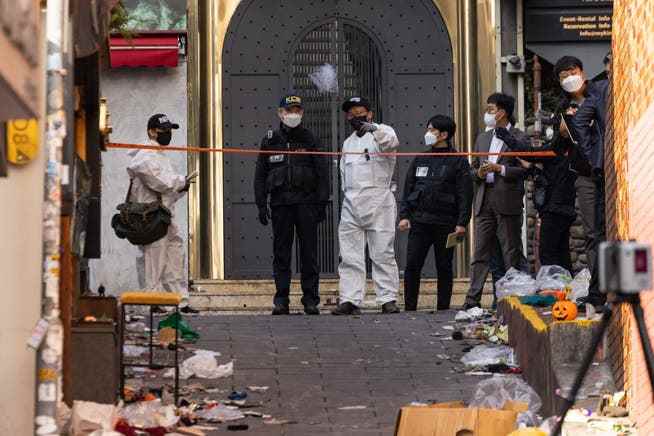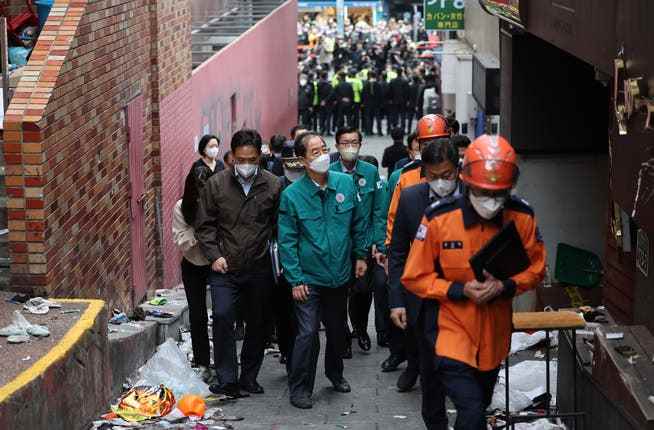With at least 154 dead, the Halloween party in the Itaewon entertainment district has become a symbol of horror. With the grief, the focus is on the work of the police.
People in South Korea remember the victims of the tragedy.
Mourning wears white in South Korea. Wearing white gloves, South Korean President Yoon Suk Yeol held a white flower as he and his wife walked to an altar for the at least 154 victims of a Halloween party on Monday morning. He devoutly laid the flower at the huge flower arrangement of the memorial in front of the city government of the capital city of Seoul. Koreans then flocked to the altar to express their sadness and shock at the tragedy that happened in a party strip of Itaewon district on Saturday night.
Where bars, nightclubs and discos crowd, more than 100,000 people had gathered to celebrate Halloween. The crowd also squeezed into a small side alley less than four meters wide. When the first people fell, this bottleneck immediately turned into a death trap.
The crowds pushed in from behind, causing bodies to fall in the crowd. Those who were at the bottom were often simply crushed to death. It is particularly tragic that it mostly affected teenagers and twenty-somethings, and then two-thirds young women. 26 foreigners were also among the victims. The traditional Halloween party in Itaewon was supposed to be the first big festival after the outbreak of the pandemic.

After the incident, an on-site investigation is being carried out into how the tragedy could have happened.
How Korea tries to mourn
Park Sokeel, South Korea head of the human rights organization Freedom in North Korea, explains that Itaewon conveys the feeling of freedom, openness and a meeting point of cultures more than any other area of the megacity. It’s a place where you can drop your masks. “It’s amazing that this energy that has been bottled up for two years is ending like this,” Park wrote on Twitter.
He’s not the only one feeling sad. There are also ugly comments that attack the victims. Prime Minister Han Duck Soo therefore felt compelled on Monday to urge the Koreans not to post any hate comments on the Internet or spread rumors. But the stories of desperate mothers and fathers from all over the world dominate the media. And society is also mourning.
Koreans lay flowers and set candles in front of the alley, as well as at Itaewon subway station and other places in the city. Buddhist monks pray for the victims. The flags are at half-staff as President Yoon declared national mourning on Sunday until Saturday. And society goes along with it.
Department stores and supermarkets ended Halloween campaigns. Many music events and fashion shows have been cancelled. These included a K-pop event that was expected to attract 40,000 people and a fashion brand Gucci event at Gyeongbok Palace.
Meanwhile, there is silence at the shared office intermediary WeWork. The company will turn off the background music during the national mourning period. Only in politics is the beginning of the search for the guilty getting louder.
South Korea’s police had no rules for crowd management
The role of the police is particularly in focus. Interior Minister Lee Sang Min said on Sunday that the accident could not have been prevented. In addition, he pointed out that security forces could also have monitored demonstrations in the city center.
Hong Ki Hyun, head of the Public Order Bureau of the National Police Department, on Monday denied suspicions that a smaller contingent had been sent to Itaewon because of this. With 137 police officers, even more than in the pre-pandemic Halloween festivals, he explained. But most of the officers were probably busy stopping crime and directing traffic, but not the crowd.
According to him, there are currently no procedural rules for such cases. Things are different in neighboring Japan. At the Halloween celebrations there in Tokyo, several hundred people were only busy directing and controlling the crowds in order to reduce the risk of an accident. The reason for the precaution was a similar mass panic in 2001: At that time, a fireworks display in the central Japanese city of Akashi killed eleven people and injured more than 200.

South Korean Prime Minister Han Duck-soo (middle) at the scene of the accident.
So far in South Korea there are only rules for organizers of events, but not for spontaneous crowds like on Saturday in Itaewon. President Yoon therefore called on the authorities on Monday to create standards for such occasions.
Fast action is very important for Yoon domestically. Just five months after taking office, he is already unpopular. And tragedies have already decided presidencies. After the sinking of the Sewol ferry in 2014, in which more than 300 people died, then-President Park Geun Hye never recovered politically from her initially slow crisis management. In 2017, after mass demonstrations against her, she was removed from office and jailed for corruption. So now Yoon can’t afford to make a misstep if he ever wants to work his way out of his mood doldrums again.
